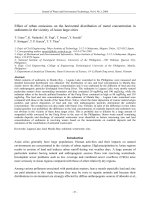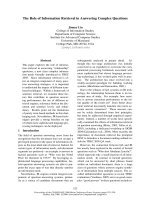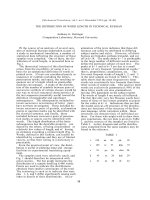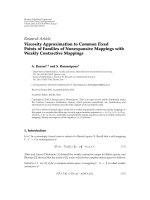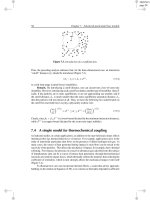Approximation to the stationary distribution of information flows in a communication network
Bạn đang xem bản rút gọn của tài liệu. Xem và tải ngay bản đầy đủ của tài liệu tại đây (651.69 KB, 98 trang )
Approximation to the stationary distribution of
information flows in a communication network
CAO YI
(B.Math, Nanjing University)
A THESIS SUBMITTED
FOR THE DEGREE OF MASTER OF SCIENCE
(MANAGEMENT)
DEPARTMENT OF DECISION SCIENCE
NUS BUSINESS SCHOOL
NATIONAL UNIVERSITY OF SINGAPORE
Aug, 2005
2
Acknowledgement
First and foremost, I would like to take this opportunity to express my sincere appreciation
to my supervisors, Assoc Prof Ou Jihong and Asst Prof Ye Hengqing. They introduced me into the area of queueing network modelling. Their enlightening instruction,
plus their comprehensive collection of research materials, allows me to deeply understand
my research topic. I am immensely grateful to them for their time and effort on this thesis
in spite of their heavy schedule and other responsibilities. Their interest and enthusiasm
in this research topic have made it possible for the completion of this thesis.
I am also grateful to A/P Thompson Teo, A/P Chou Cheng Feng, Ms. Ang
Chin Teng, Ms. Lim May Lin, and of course my supervisors, for the time you shared
with me in personal conversation and sincere communication, and your greatest support.
Lastly, I dedicate this thesis to my parents, who continually encourage and support
me to pursue my goal, who love me most and who I love most.
i
ii
ACKNOWLEDGEMENT
Contents
Acknowledgement
i
Summary
vii
1 Introduction
1
1.1
Background . . . . . . . . . . . . . . . . . . . . . . . . . . . . . . . . . . .
1
1.2
Motivation . . . . . . . . . . . . . . . . . . . . . . . . . . . . . . . . . . . .
4
1.3
Research contribution . . . . . . . . . . . . . . . . . . . . . . . . . . . . . .
6
1.4
Organization of the thesis . . . . . . . . . . . . . . . . . . . . . . . . . . .
8
2 Literature Review
2.1
2.2
11
Communication network . . . . . . . . . . . . . . . . . . . . . . . . . . . . 11
2.1.1
Bandwidth allocation . . . . . . . . . . . . . . . . . . . . . . . . . . 12
2.1.2
Stability conditions . . . . . . . . . . . . . . . . . . . . . . . . . . . 13
2.1.3
Stationary distribution . . . . . . . . . . . . . . . . . . . . . . . . . 13
Approximation methods . . . . . . . . . . . . . . . . . . . . . . . . . . . . 15
2.2.1
Decomposition method . . . . . . . . . . . . . . . . . . . . . . . . . 15
2.2.2
Diffusion approximation . . . . . . . . . . . . . . . . . . . . . . . . 17
2.3
Gibbs sampling method . . . . . . . . . . . . . . . . . . . . . . . . . . . . 18
2.4
Chapter summary . . . . . . . . . . . . . . . . . . . . . . . . . . . . . . . . 19
iii
iv
CONTENTS
3 The Communication Network Model
21
3.1
The Network framework . . . . . . . . . . . . . . . . . . . . . . . . . . . . 21
3.2
Bandwidth allocation rule . . . . . . . . . . . . . . . . . . . . . . . . . . . 24
3.3
Stationary distribution . . . . . . . . . . . . . . . . . . . . . . . . . . . . . 27
3.4
Chapter summary . . . . . . . . . . . . . . . . . . . . . . . . . . . . . . . . 30
4 Approximation Procedure
33
4.1
Modelling processor sharing queues . . . . . . . . . . . . . . . . . . . . . . 33
4.2
Approximation algorithm . . . . . . . . . . . . . . . . . . . . . . . . . . . . 36
4.3
Chapter Summary . . . . . . . . . . . . . . . . . . . . . . . . . . . . . . . 43
5 Gibbs Sampling Method
45
5.1
Generic Gibbs sampling method . . . . . . . . . . . . . . . . . . . . . . . . 46
5.2
Modified Gibbs sampler . . . . . . . . . . . . . . . . . . . . . . . . . . . . 49
5.3
Multiple path sampling . . . . . . . . . . . . . . . . . . . . . . . . . . . . . 50
5.4
Modified Gibbs sampling algorithm . . . . . . . . . . . . . . . . . . . . . . 52
5.5
Chapter summary . . . . . . . . . . . . . . . . . . . . . . . . . . . . . . . . 53
6 Numerical Study
6.1
55
Networks with analytical solution . . . . . . . . . . . . . . . . . . . . . . . 57
6.1.1
Standard linear network . . . . . . . . . . . . . . . . . . . . . . . . 57
6.1.2
The grid network . . . . . . . . . . . . . . . . . . . . . . . . . . . . 63
6.1.3
Single bottleneck . . . . . . . . . . . . . . . . . . . . . . . . . . . . 65
6.2
Network without analytical solution . . . . . . . . . . . . . . . . . . . . . . 68
6.3
Truncation error
6.4
Chapter summary . . . . . . . . . . . . . . . . . . . . . . . . . . . . . . . . 74
. . . . . . . . . . . . . . . . . . . . . . . . . . . . . . . . 72
CONTENTS
7 Conclusion
v
77
7.1
Overview . . . . . . . . . . . . . . . . . . . . . . . . . . . . . . . . . . . . . 77
7.2
Summary of findings . . . . . . . . . . . . . . . . . . . . . . . . . . . . . . 77
7.3
Implications of study . . . . . . . . . . . . . . . . . . . . . . . . . . . . . . 78
7.4
Limitations of study . . . . . . . . . . . . . . . . . . . . . . . . . . . . . . 78
7.5
Suggestions for future research . . . . . . . . . . . . . . . . . . . . . . . . . 79
Reference
80
vi
CONTENTS
Summary
In this study we propose a procedure to approximately compute the stationary distribution
of the number of transmitting information flows in a communication network.
The flows arrive to the network according to Poisson processes with exponentially
distributed flow volumes, and traverse through a fixed path of transmission links in the
network. The links have finite transmission capacities which are allocated to the information flows concurrently transmitting in the network according to some dynamic bandwidth
sharing rule, which ensures the stability of the total number of information flows ongoing
in the network.
The procedure is based on dynamic approximation of the bandwidths allocated to
concurrent information flows in the network. Numerical examples show that the procedure
produces the numerical solution of the network within 2% of the true values.
vii
viii
SUMMARY
Chapter 1
Introduction
1.1
Background
This thesis proposes an approximation algorithm for computing the stationary joint distribution of the number of ongoing connections (or information flows) in a communication
network. This type of communication network is widely used to model the modern data
transmitting communication network such as today’s Internet, rather than the telecommunication network and manufacture job shop, etc. In the latter cases, the traditional
queueing network such as the Jackson network or the BCMP network is used.
In recent years, the increasing volume of digital media file transmitting in the network
and the heavy visiting rate to some news websites upon the occurrence of some worldwide
events such as the 911 have deteriorated the previously high performance of the Internet, because the current network traffic control mechanism is designed for the small file
transmission situation, rather than today’s demanding situation. Therefore the network
is once again put up on the researchers’ table.
An abstract framework of this communication network comprises a set of routes con1
2
CHAPTER 1. INTRODUCTION
necting a pair of nodes that are the possible source and destination of information flows,
which can be voice conversations in a telephone network, or the digital documents in a
data network like the Internet, and a set of transmission links. A simplified example of
this communication network with two links and three routes is illustrated in Figure 1.1,
associated with its abstraction in Figure 1.2. Each route carrying an amount of information flows traverses through a fixed subset of links; while each link has a transmission
bandwidth capacity, which will by some dynamic bandwidth allocation rule, be shared
among the routes that traverse through it. The bandwidth allocated to each route is
uniquely determined accordingly, facilitating the transmission of these information flows.
Figure 1.1: Communication Network
When an information flow carrying an amount of data arrives on a given route, a
connection is established on that route. After the transmission is finished, the connection
is terminated. The same as the traditional queueing network such as the manufacturing
or service network, the communication network can be characterized by the fluctuation
of the number of ongoing connections on each route in the network. However, different
from a job in a manufacturing job shop or a customer in a service system that visits the
1.1. BACKGROUND
3
Figure 1.2: Communication Network Model
service stations along its route one at a time, an information flow in the communication
network takes up resources simultaneously at all the links along its transmission route.
A fundamental issue about this communication network is how to allocate the link’s
bandwidth capacity to the routes that traverse through it. If we imagine the transmission
process on each route as a queueing system, it can be seen that the bandwidth allocation
according to some bandwidth allocation rules determines the service rate associated with
each queue (route).
An Additive Increase Multiplicative Decrease bandwidth allocation algorithm is implemented in the TCP (the traffic control protocol) of the Internet (see Chiu and Jian
1989, Chiu 2000). However, it is observed that the TCP algorithm favors shorter round
trip time. Bertsekas and Gallager (1992) discussed the Max-min fairness bandwidth allocation algorithm which intended to maximize the minimum bandwidth allocated to each
route.
Kelly (1997, 1998) proposed the concept of proportional fairness bandwidth allocation
and developed a decentralized algorithm to implement it. The objective of the allocation
rule was to maximize the overall utility of the bandwidth allocations by assuming each
route had the logarithmic utility function.
4
CHAPTER 1. INTRODUCTION
Mo and Walrand (2000) generalized the above results. They proposed a general form
of optimization problem that solved the bandwidth allocations. They referred it as the α
proportional fairness allocation. The Max-min and Kelly’s proportional fairness allocations are then the special cases of the α allocation rule.
These fairness bandwidth allocation rules are critical to another important aspect of
the network, the stability of the network: whether or not the bandwidth allocated to
each route is enough to digest the workload. It may be intuitive that the normal offered
load condition is sufficient, that is the total traffic load on each link is within the link’s
capacity. Unfortunately, Bonald and Massoulie (2000) presented some examples showing
that for some priority bandwidth allocation rules, the condition is insufficient. However,
many studies show that when the various fairness allocation rules are applied instead, the
normal offered load condition is sufficient. See De Veciana et.al (2001)’s discussion for
the max-min fairness allocation, Bonald and Massoulie (2000)’s for the general α fairness
bandwidth allocation, and Ye (2003)’s for the more general utility maximizing bandwidth
allocation under general traffic conditions.
1.2
Motivation
Although many studies have been conducted for this communication network, compared
to the rich analytical results for the traditional queueing network, little has been available
for this network. Lying at the bottom line of those analytical results is the stationary
distribution of the queueing length of each queue in the network. However, even for most
traditional queueing networks, the analytical solutions are not permitted. It adds on
extra difficulty for this communication network due to its special bandwidth allocation
1.2. MOTIVATION
5
characteristics. It is the complexity introduced by the bandwidth allocation rule in the
network that precludes to derive the simple closed form solution, e.g. a product form
solution, for the stationary distribution of the system. In particular, Chiu (2000) showed
the solution is not of product form for a particular network example.
Up to now, only for a few networks with simple structure and certain bandwidth
allocation rule, the closed form solutions are derived (see Fayolle et.al 2001). Masoullie
and Roberts (1998) showed the closed from solution for the linear network, Bonald and
Massoulie (2000) further found the solution for the grid network by solving the same full
balance equations. They suggested that the closed form solution for the network that
violates the strict underlying assumptions is unavailable.
Instead, we may resort to the numerical solution by solving the Markov transition rate
matrix. However, when the state space is too large, such as a network with too many
routes, solving the huge matrix is impractical due to the ”curse of dimensionality”.
It thus stimulates our interests to design an approximation method to fill the gap,
as what has long been done for those traditional non-product form queueing networks.
The underlying idea of our algorithm is to decompose the network into disjoint routes
with each one being represented by an M/M/1 processor sharing (PS) queue. The service
capacity is random in that it is dynamically approximated by taking into account the
interdependence of the bandwidth allocations on all the other transmission routes. In
particular, the transmission bandwidth on each route is estimated based on the current
states of all the other routes in the network. The procedure is then iterative: it first
computes the marginal distribution of the number of ongoing connections on one route,
which provides the base to compute the joint distribution of two routes, etc.
The same idea of decomposition approach was developed to approximately compute
6
CHAPTER 1. INTRODUCTION
the stationary distributions of the traditional queueing network that does not permit
the closed form solution. The seminal works include Bitran and Tirupati (1988) and
Whitt (1983), and the more recent ones can be found in Whitt (1995) and (1999). The
procedure we construct here is a first attempt to compute (approximately) the stationary
distribution for a queueing network with the simultaneous resource consumption (SRC)
characteristics. The decomposition approach is modified here in that each isolated queue
is not statically separated from the others but rather dynamically linked in the estimation
of the processing capacity.
1.3
Research contribution
As we have mentioned, the data transmitting communication network such as the Internet is once again a hot topic today. In recent years, the increasing volume of digital file
transmitting in the network and the heavy visiting rate to some websites have largely
deteriorated the previously high performance of the Internet, because the current network traffic control mechanism is not suitable for today’s demanding situation. Thus
improvements are introduced, such as the new bandwidth allocation rules other than the
TCP.
Consequently how to evaluate the performance of the network in the context of these
new improvements becomes an urgent subject. But the very few analytical results available up to now is disappointing. Although we have the closed form solutions for some
simple networks, there is still no clues how the solution looks like for the general network.
Our approximation method is trying to fill the gap. It provides a very accurate numerical solution to this network. Numerical examples indicate that the approximation
error falls within a very small margin of the true solution. As another feasible method,
1.3. RESEARCH CONTRIBUTION
7
even the most effective modern statistical method, namely the Gibbs Sampling method
under-performs. Thus we can expect that those communication networks with the modest
size could now be solved with a high degree of accuracy. To best of our knowledge our
method is the first general approximation procedure that provides the numerical solution
to this communication network.
Our algorithm has two advantages over those analytical results that are currently
available. One is that it is independent of the specific structure of the network in that it
can be applied to any such communication network without adjusting the algorithm to
accommodate its specific structure. The network structure is automatically reflected in
the dynamic bandwidth allocation rule, a subfunction in our algorithm.
Another advantage is that it is independent of the specific bandwidth allocation rule.
The bandwidth allocation rule is packaged in a sub-function and called by the main
function in our algorithm. This feature is of practical use. Because those newly developed
bandwidth allocation rules can be tested here in terms of their distinctive impact on the
network performance. We just modify the subfunction to accommodate the specific rule.
There are some practical usages as well. For example, in a large network, the accurate
solution of the system is not the first concern. The network administrator is concerning
with the bottleneck of the network. In this case, we pursue the speed of the solution rather
than the accuracy by introducing larger truncation error. Then the marginal distribution
of each route, which is more accurate than the joint distribution of the system when
the truncation error is large, will provide information about the dynamics of each route,
indicating where the network is in heavy traffic condition and where light traffic. This
result is definitely not achievable through the inefficient simulation method, or any other
local approximation methods that isolate routes for tractability.
Given the information of the traffic on each route, we can further adjust the settings
8
CHAPTER 1. INTRODUCTION
of the algorithm, such that the truncation on each route is treated individually. This adjustment will improve the computational efficiency as well as the accuracy of the solution
of the system.
1.4
Organization of the thesis
The organization of this thesis is as follows. The following chapter of literature review will
provide the well round background of our study. We will first study the communication
network which is the subject of this study. The network structure, various bandwidth
allocation rules, and the current achievement of some analytical results will be covered.
Since the analytical results for the communication network are relatively rare, we will
resort to the traditional queueing networks such as the Jackson and BCMP network to
search for insights from their rich numerical approximation toolbox. The most effective
approximation methods for the non-product form queueing network will be reviewed.
Finally some modern statistical tools developed in the last decade as a very effective way
to compute the complex probability distribution will be briefly introduced. In particular,
we will briefly investigate the modern sampling method, namely the Gibbs sampling
method, which makes computing the complex probability distribution easy by using the
modern computational power.
Chapter 3 formulates the framework of the communication network under study, and
discusses the various issues that are critical to the network. In Chapter 4, we proposes
the approximation algorithm to compute the solution of the network numerically. The
modified Gibbs Sampling which provides an alternative method, other than the ineffective simulation method, to derive the benchmark solution of the network for comparison
purpose is the subject of Chapter 5. Numerical results are presented in Chapter 6, in
1.4. ORGANIZATION OF THE THESIS
9
which we compare the results of our approximation algorithm with those from the Gibbs
sampling method and the rare analytical results. Chapter 7 concludes our study.
10
CHAPTER 1. INTRODUCTION
Chapter 2
Literature Review
This chapter consists of three parts. Section 2.1 discusses this communication network
under study. Various issues critical to the network and some current achievements will
be covered. Section 2.2 resorts to the rich set of the approximation methods for the
traditional queueing network to look for insights. Two major approximation methods
for the non-product form queueing network are discussed in detail. The development of
the modern statistical method as an alternative but very effective method to compute a
complex probability distribution is the subject in Section 2.3. Section 2.4 summaries this
chapter.
2.1
Communication network
The data transmission communication network such as the Internet has been there for a
decade. In recent years, it is observed that the increasing volume of large file transmitting
in the network and the heavy network traffic have seriously deteriorated the previously
high performance of the network, because the current network traffic control mechanism
is designed for the small file transmission situation, not suitable for today’s demanding
11
12
CHAPTER 2. LITERATURE REVIEW
situation. Therefore the network is once again a hot topic.
2.1.1
Bandwidth allocation
One of the fundamental questions related to improving the network performance in the
new environment is how to allocate each link’s bandwidth capacity among those transmission routes that traverse through it, such that the network can effectively handle the
workload on each route.
Bertsekas and Gallager (1992) discussed the Max-min bandwidth allocation algorithm
which intended to maximize the minimum bandwidth allocated to each route such that
the minimum transmission rate is improved. It was later proved that this allocation is
the fairest bandwidth rule. (De Veciana et.al 2001)
Kelly (1997, 1998) proposed another, namely the Proportional fairness rule. This
bandwidth allocation maximized the overall utility of the network by assuming a logarithmic utility function. From the mathematic perspective, Kelly’s study suggested that
the bandwidth allocation could be obtained by solving an optimization problem, preassuming the number of ongoing connections on each route was fixed.
Later on, this idea was further developed by Mo and Walrand (2000). They considered a more general optimization problem. The corresponding bandwidth allocation was
referred as the α proportional fairness bandwidth allocation rule. This allocation rule
includes a wide range of allocation rules, such as the max-min rule, Kelly’s proportional
fairness rule, etc. Moreover, a weighting factor wr was introduced into the optimization
problem of the α allocation rule. (see Bonald and Massoulie 2000)
Ye (2003) considered a more general bandwidth allocation rule, named the U- utility
maximizing allocation rule, based on Kelly (2001) and Low (2003)’s work. This rule
maximized a more general form utility function aiming to approximate the current TCP
2.1. COMMUNICATION NETWORK
13
allocation rule.
2.1.2
Stability conditions
Another important issue is the stability condition of the network, under which the mean
number of ongoing connections on each route will remain finite, not grow into infinite in
the long run. Intuitively, it is expected that the normal capacity constrain on each link
is a sufficient condition, which is also referred as the normal offered load condition.
Unfortunately, Bonald and Massoulie (2000) showed for some networks with the priority bandwidth allocation rules, this condition is insufficient. They concluded that in the
absence of the fairness prerequisite, the bandwidth allocation rules of Pareto efficiency was
not sufficient to guarantee the stability of the network under the normal traffic condition.
According to their suggestion, the stability problem was then studied when some
certain fairness bandwidth allocation rule was applied. Some recent results were found in
Massoulie and Roberts (1998) for Kelly’s rule, De Veciana et.al (2001) for max-min rule.
Bonald and Massoulie (2000) provided the stability results under the general α bandwidth
allocation rule, by using a Fluid model. Ye (2003) provided similar stability results for a
more general bandwidth allocation, the U-utility maximizing allocation. Ye et.al (2003)
extended the results to the network with general stationary arrival process.
2.1.3
Stationary distribution
Rich studies are conducted in the static context, in that the number of ongoing connections on each route is fixed during the period of study. Little has been done to study
the stochastic behavior of the network (Massoulie and Roberts 1998), of which the fundamental question is the dynamic of the state of the system.
In rare cases where the full balance equations are applicable, the system is solved
14
CHAPTER 2. LITERATURE REVIEW
by using the traditional Markov chain technique. For example, Massoulie and Roberts
(1998) provided the close form solution for the linear network under Kelly’s Proportional
fairness rule. Bonald and Massoulie (2000) extended the above results to Grid network,
the generalization of the linear network.
They added on that the analytical result was not available for the more general network
where the strict underlying assumptions were not satisfied. See Fayolle et.al (2001) for
the similar comments and their study of the approximation method to the star shaped
network.
2.2. APPROXIMATION METHODS
2.2
15
Approximation methods
Long before the fast development of the communication network, the traditional queueing
network has been extensively studied since Jackson’s seminar work (Jackson 1957,1963),
and later the BCMP theory (Baskett et.al 1975). These networks have an attractive
property that the stationary joint distribution of the system could be explicitly expressed
in a product form. But in more general cases where the local balance equations are
not available, most queueing networks do not permit the product form solution. Only
by approximation methods can we obtain an approximated solution. Among them, the
most effective approximation method, namely the decomposition method, borrowed the
underlying idea of Jackson’s product form solution.
2.2.1
Decomposition method
Although the queueing network is difficult to analyze in a whole, it can be divided into
several small subnetworks, in the extreme case each subnetwork consisting of only one
queue. Then each subnetwork is analyzed individually. Finally by taking into account
the interaction between the different subnetworks, the individual results are combined
together to obtain the approximated solution to the entire network.
Based on this idea, this method is widely used when the queues of the network can
be divided into weakly interrelated groups. The advantage of this method is that it
requires little on the computational time which is independent of the size of the entire
network. While the disadvantage is that the uncertainty of the accuracy level of the
solution remains, and the convergence of the solution is not guaranteed (Gelenbe and
Pujolle 1987).
As noted by Harrison and Petal (1993), the decomposition method gave a very accu-
